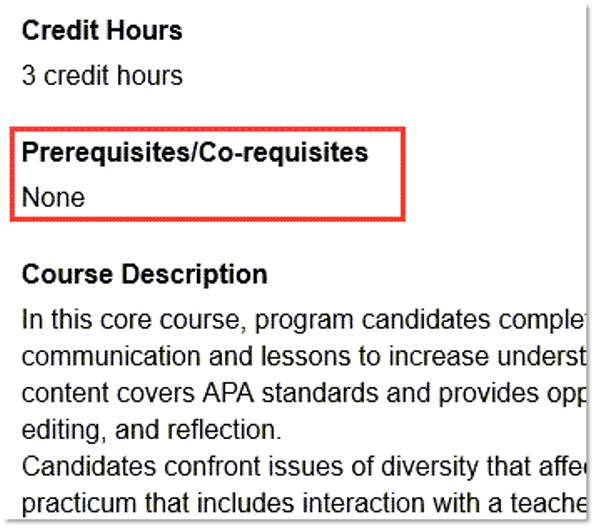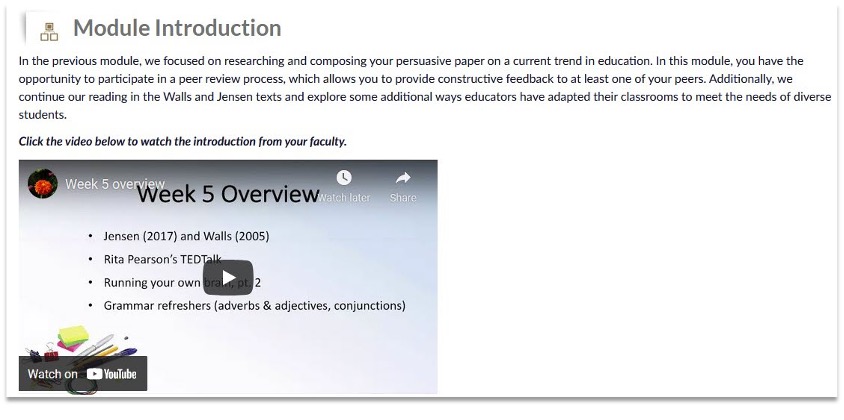Never worked in an LMS template before or worried about the course quality review process? Use our instructional designers’ favorite course building tips below to help prepare yourself for some of the most commonly missed quality review standards and challenging elements of working in an LMS.
Prerequisites & Co-requisites
Specific Review Standard 1.7 of the Quality Matters Rubric asks that learners be made aware of any prerequisites or co-requisites for the course even if your course does not require any. Typically, this information is included early your course syllabus but may also be provided on an informational page about your course.

Course Grading Policy
Specific Review Standard 3.2 of the Quality Matters Rubric addresses the need for a clearly written statement for how grades are calculated in a course.
Not only does this include an institutionally determined grading scale (e.g., an A is between 90-100%), but the standard also requires the identification of a course grading scale. This scale can constructed to the preferences of the course instructor. For example, this can be provided in a percentage- or points-based format. Regardless of format, the scale must include all required assignments and assessments in the course.

Introduction
In order to prepare your students for a new learning unit, key up essential content and activities in the module overview page using brief text explanations and/or video introductions.

Objectives and Activities
Alignment is an essential component for the quality review and impacts many essential, three-point standards. Indicating alignment across your course overview pages is key to performing well during the review process. On your overview pages, indicate the aligned Course Objective with all module objectives using the designation CO#.
You should also include the alignment you identified on your course map for your activities and assignments. Indicate the alignment on these items using the designation MO#. Your completed course map should contain this information:

Alignment and Due Dates
Continue indicating alignment across all assessments and activities. In addition to this detail, the overview page should also contain the due dates for the assigned assessments and activities. We recommend including due dates based on day of the week instead of calendar dates. This makes it easier to update the course each term it is taught.

Add Context
As a best practice, include written context for students around why the learning materials are essential. Model teaching behaviors you already utilize in your face-to-face courses:
- Draw connections to real-world applications
- Elaborate on how learning materials connect to activities and assignments
- Provide food-for-thought commentary or guiding questions
Most importantly, avoid simply uploading readings or slide decks for students to work through on their own without your presence to facilitate their learning.

Model Academic Integrity
Specific Review Standard 4.3 addresses modeling academic integrity for students using a discipline-appropriate citation style (e.g., APA, MLA, or Chicago). It is a best practice to provide reference information for images, non-instructor created videos, articles, or websites. Not only does this model correct behaviors for academic integrity, the inclusion of regular citations help familiarize students with citation language.

Self-Describing Hyperlinks
Specific Review Standard 8.1 addresses what is called “self-describing hyperlinks.” This means that all links, files, and icons “are labeled with easy-to-understand self-describing, and meaningful names.” But why is this a QM requirement? Students who utilize screen readers navigate through pages and documents link-by-link. If a student using a screen reader lands on a hyperlink, the screen reader will read the full text of the hyperlink (with all the numbers, hyphens, and letters).
Incorrect Hyperlink Text
- https://sites.google.com/view/edu5111resources/home
- Click here to see the website.
- Copy-and-paste this link into your web browser: https://sites.google.com/view/edu5111resources/home
Correct Hyperlink Text
- Visit the quick guide to pages in Hacker and Sommers (2019) for commonly used APA citations.
Closed Captioning
Specific Review Standard 8.4 addresses the inclusion of alternative access to multimedia content for diverse learners. This includes having captions (or transcripts) for both instructor-created videos and third-party videos as illustrated by the CC symbol on the YouTube example below.

Accessible Documents

Specific Review Standard 8.3 addresses the use of accessible text and images in files, documents, LMS pages, and web pages to meet the needs of diverse learners.
Use Microsoft’s built-in Accessibility Checker to scan Microsoft products including Word, PowerPoint, Excel, and Outlook for potential accessibility issues.
Work to resolve any errors; consider resolving any warnings or tips.


